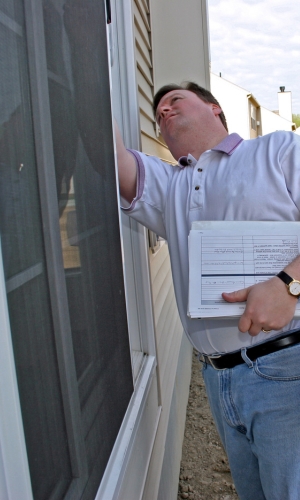What to Do After a Hailstorm: Roof Inspection Checklist for Colorado Springs Homes
Hailstorms are a common occurrence in Colorado Springs, and they can cause significant damage to your roof, especially during the spring and summer months. While it may seem like the storm has passed and everything is fine, hail can leave behind hidden damage that could result in leaks, structural issues, or costly repairs if not addressed promptly.
At RIZE Roofing, we’re here to help homeowners protect their roofs from the unpredictable Colorado weather. In this blog, we’ll walk you through a comprehensive roof inspection checklist to follow after a hailstorm, so you can identify potential issues early and prevent long-term damage to your home.
1. Wait for the Storm to Pass (Safety First!)
Before inspecting your roof, wait for the storm to pass and make sure the area is safe. Never attempt to climb onto your roof during or immediately after a hailstorm—conditions can be dangerous, with debris, downed power lines, and slippery surfaces. Once it’s safe to go outside, follow these steps to assess your roof’s condition.

2. Check for Visible Roof Damage from the Ground
You can start inspecting your roof from the ground level before climbing up. Walk around your property and look for signs of visible damage, which may include:
- Dented or broken shingles: Hailstones can cause cracks or break shingles, leaving your roof exposed to the elements.
- Granule loss: Asphalt shingles are covered with granules that protect them from UV rays and water damage. Hail can strip these away, making the shingles less effective.
- Missing or displaced shingles: Large hailstones can dislodge shingles, leaving your roof vulnerable to leaks.
- Damaged gutters: Check for dents or holes in your gutters, as they can affect the drainage system and cause water backup on your roof.
- Debris buildup: Fallen branches, leaves, or even large hailstones may collect on your roof and cause further damage if left unattended.
3. Inspect the Attic for Leaks or Water Damage
After a hailstorm, it’s important to check your attic for any signs of leaks or water damage. Here’s what to look for:
- Water stains on the ceiling: Any dark spots or yellow stains on your attic ceiling may indicate that water has seeped through your roof.
- Mold or mildew: Check for mold growth or a musty smell, which can signal hidden moisture problems.
- Damp insulation: If your attic insulation feels wet, it could mean that the roof has been compromised.
If you notice any of these signs, call RIZE Roofing immediately for a full roof inspection and repairs.
4. Check for Dents or Damage to Flashing and Vents
Hail can damage not just your shingles, but also your roof flashing and vent pipes. Flashing, which protects the joints of your roof, is susceptible to dents and cracks. Damaged flashing can lead to water penetration, which can cause leaks over time.
Check the following areas:
- Chimney and skylight flashing: Look for any cracks or bent metal that may allow water to seep in.
- Vent pipes: Examine the roof vents to ensure they haven’t been cracked or dislodged by hail.
5. Inspect the Roof’s Structure (if Safe)
If the storm was particularly severe and you feel safe to do so, check for any obvious damage to the roof structure. Look for:
- Sagging or soft spots: These could indicate that water has infiltrated the roof deck, weakening the structure.
- Loose or displaced roof components: If any of the roofing materials have shifted, your roof may need reinstallation or reinforcement.
6. Contact Your Insurance Company for a Claim
If you find significant hail damage, contact your insurance company as soon as possible to start the claims process. Many policies will cover roof repairs or replacements caused by hail, and the sooner you file a claim, the better.
Here’s what you’ll need:
- A list of visible damage (shingles, gutters, flashing, etc.)
- Photos of the damage
- A roofing inspection report from RIZE Roofing (we can help with this!)
We recommend calling a professional roofing contractor before you file your claim. An experienced contractor like RIZE Roofing can provide a detailed inspection and documentation that will help support your claim.
7. Schedule a Professional Roof Inspection
After a hailstorm, it’s always best to schedule a professional roof inspection. RIZE Roofing specializes in roof inspections and storm damage assessments in Colorado Springs and the surrounding areas. We’ll:
- Perform a thorough inspection of your roof, attic, and gutters
- Identify any hidden or hard-to-spot damage
- Help you understand your insurance coverage and assist with claims
- Provide expert advice on whether repairs or a full replacement is needed
8. Prevent Future Damage with Roof Maintenance
Once your roof is repaired, consider regular maintenance to prevent future damage:
- Regular cleaning to remove debris and prevent water damage.
- Tree trimming to prevent branches from damaging your roof in the next storm.
- Annual roof inspections to catch issues before they worsen.
Why Choose RIZE Roofing for Roof Inspections and Repairs?
Expertise: We specialize in hail damage assessments and roof repairs in Colorado Springs, and we’re familiar with the unique weather challenges in our area.
Insurance Assistance: We’ll work with your insurance company to ensure you get the full benefit of your coverage.
High-Quality Repairs: Our skilled team will handle all repairs with the highest standards, ensuring your roof is in top condition.
Free Estimates: We offer no-obligation quotes for any necessary repairs or replacements.
Schedule Your Roof Inspection Today
If your home was hit by a hailstorm, don’t wait to assess the damage. Early detection and prompt repairs can save you from costly repairs down the line. Contact RIZE Roofing today for a free roof inspection and expert storm damage assessment.
Call now to schedule your roof inspection in Colorado Springs and keep your home safe from the next storm!

